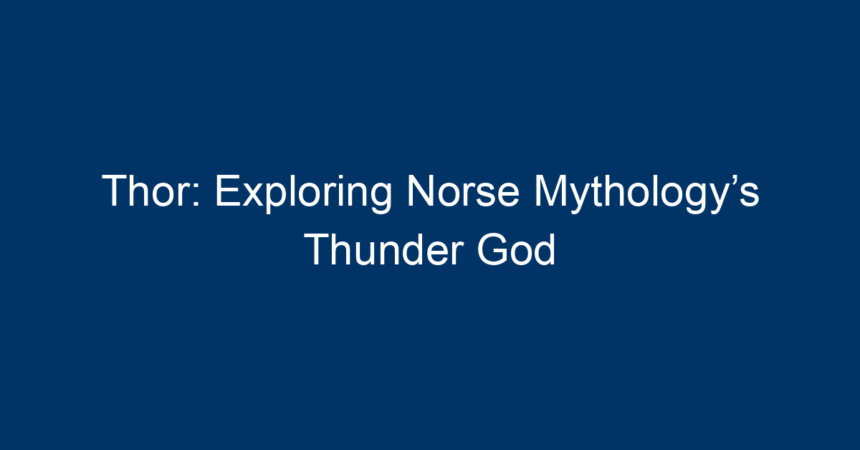Norse mythology is filled with fascinating tales of gods, giants, and mythical creatures, but none is as iconic as Thor. Widely recognized today through popular culture, especially in Marvel comics and films, Thor stands as a symbol of strength, protection, and bravado. In this article, we will dive deep into the origins, stories, and cultural significance of Thor, the thunder god who wielded Mjölnir and defended both gods and humanity from chaos and destruction.
The Origins of Thor
A Family Background
Thor, known as Þórr in Old Norse, is primarily the son of Odin, the chief of the Aesir gods, and Jord, the earth goddess. His heritage mixes divine strength and earthly vigor, which is often reflected in his personality traits. Born into power and authority, Thor is not only a formidable warrior but also someone who embodies the virtues of honor and loyalty.
Thor in the Poetic Edda
Our understanding of Thor primarily comes from two medieval texts: the Poetic Edda and the Prose Edda. The Poetic Edda, a collection of Old Norse poems, paints a vivid picture of Thor’s adventures, emphasizing his role as a protector. Notable tales include his battles against trolls and giants, showcasing his bravery and combat prowess.
The Prose Edda, written by Snorri Sturluson in the 13th century, provides further narratives about Thor and offers insight into Norse cosmology. These texts not only serve as literary works but also as cultural archives that reflect the values of the Viking Age.
The Symbolism of Thor
Thunder and Strength
Thor is primarily known as the thunder god, a powerful figure associated with storms and battle. His hammer, Mjölnir, is a symbol of protection, capable of leveling mountains and capable of returning to him after being thrown. The imagery associated with Thor often invokes lightning, reflecting his volatile but essential nature.
Fertility and Agriculture
Interestingly, Thor’s influence isn’t restricted to war and chaos. He is also a god of fertility and the harvest. Farmers venerated him, praying for rain and good harvests. The duality of Thor—both a warrior and a nurturer—highlights the interconnectedness of destruction and creation in nature, a theme prevalent in Norse mythology and, indeed, many other mythologies worldwide.
The Modern Depiction of Thor
In contemporary culture, Thor has been popularized by films and comics, most notably the Marvel Cinematic Universe. This portrayal often amplifies his strength and heroism but somewhat simplifies his complexities. Nevertheless, it raises interest in Norse mythology, drawing new generations to explore the deeper meanings behind these ancient tales.
Iconic Stories of Thor
The Journey to Jotunheim
One of the quintessential tales involves Thor’s journey to Jotunheim, the land of the giants, alongside Loki, the trickster god. Seeking to prove his strength, Thor engages in a series of challenges, such as drinking from the ocean, wrestling an old woman (who turns out to be Old Age), and lifting a giant’s cat (which is actually the Midgard Serpent in disguise). These stories illustrate his resilience against insurmountable odds, emphasizing tenacity in overcoming adversity.
Thor’s Hammer, Mjölnir
The story of how Thor acquired his mighty hammer is just as captivating. After Loki, in a fit of mischief, cuts the hair of Sif (Thor’s wife), he seeks to appease Thor by persuading the dwarves to create magical items, one of which is Mjölnir. This hammer becomes more than just a weapon; it symbolizes Thor’s duty as a defender of the gods and humanity against chaos.
Ragnarok: The Final Battle
Ragnarok, the cataclysmic event foretold in Norse mythology, is another pivotal story involving Thor. In this ultimate battle, Thor faces the Midgard Serpent, where he successfully confronts the creature but meets his demise shortly afterward, foreshadowing the cyclical nature of life, death, and rebirth in Norse lore. This symbolism underscores the fragility of existence and the inevitable bringer of change, even for the mightiest of gods.
Thor’s Cultural Impact
Historical Worship
During the Viking Age, Thor was one of the most revered deities. Frescoes and carvings depicting Thor’s hammer were common among Norse societies, functioning as amulets for protection and symbols of faith. The sacredness attributed to Thor and his hammer reflects the intertwining of spirituality with everyday life in that era.
Modern Interpretations
In today’s world, Thor’s image is often co-opted for various purposes. From merchandise to tattoos, he embodies strength and resilience. Additionally, Asgardian aesthetics have influenced literature, art, and even fashion, echoing the ancient Norse values of bravery and community.
Thor in Literature
Many modern authors draw inspiration from Thor’s stories. For instance, Neil Gaiman’s novel "Norse Mythology" retells these ancient tales for a contemporary audience, bringing new life to these stories and making them accessible to those unfamiliar with Norse legends.
Conclusion
Thor, the thunder god, embodies much more than mere physical strength; he represents the eternal conflict between chaos and order, destruction and protection, vulnerability and resilience. His adventures, filled with trials and triumphs, continue to resonate with audiences today, bridging the gap between ancient myths and modern narratives.
Actionable Insights
-
Explore Norse Mythology: Delve deeper into other Norse gods and stories to understand the interconnectedness of their roles and characteristics.
-
Engage with Modern Adaptations: Follow contemporary retellings and adaptations of Thor to appreciate how ancient narratives morph over time.
-
Cultural Understanding: Reflect on how ancient myths like Thor’s can inform current values surrounding bravery, community, and protection against chaos.
-
Visit Historical Sites: If possible, consider visiting sites in Scandinavia where Norse mythology was born, like ancient burial grounds and Viking museums.
- Discuss and Share: Share your thoughts on Thor and other Norse myths with friends and online communities, expanding the discussion on these timeless stories.
By exploring Thor’s character, both in ancient contexts and modern interpretations, we gain insight into an enduring legacy that continues to inspire strength and courage in the human experience.




